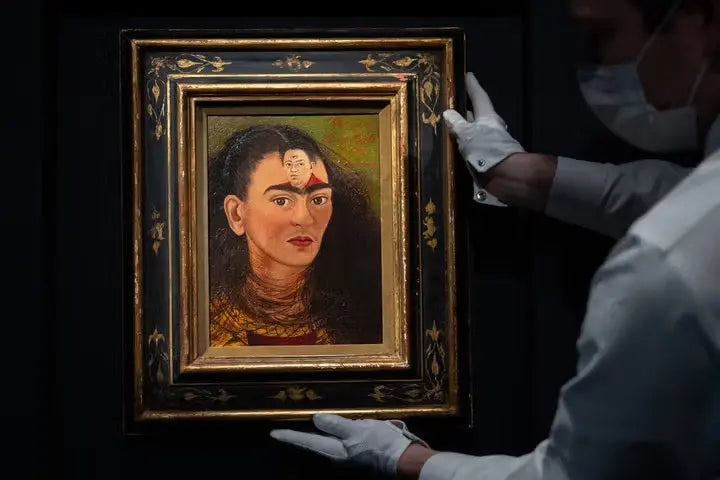Frida Kahlo, an emblematic figure of Mexican art, continues to fascinate the world with her work and her tumultuous life. Rebel artist, committed woman, Kahlo left an indelible mark on the history of art. In this article, we invite you to dive into the world of this extraordinary artist.
A Birth Under the Sign of Controversy
Identity and Political Engagement
Frida Kahlo, born Magdalena Frida Carmen Kahlo y Calderón, chose to simplify her name for both practical and symbolic reasons. Even more interesting, she changed her birth date to coincide with the start of the Mexican Revolution in 1910. This gesture was not insignificant; it reflected his desire to align with revolutionary ideals and emphasize his deep attachment to his country, Mexico. This deliberate choice shows the extent to which Frida was politically and socially engaged from a very young age.
An Affirmation of Identity
By changing her date of birth, Frida Kahlo not only expressed her political commitment, but also her desire to define herself on her own terms. She used this gesture to reinvent herself and position herself as an iconic figure in the Mexican Revolution, even though she did not directly participate in it.
A journey strewn with pitfalls
Physical Tests
Frida Kahlo experienced many challenges from a young age. Suffering from poliomyelitis at the age of 6, she was nicknamed "Frida the Lame" during her schooling. At 18, she survived a tragic bus accident that left her with serious injuries and lifelong effects. These ordeals were a source of inspiration for his art, where pain and suffering are recurring themes.
Art as Therapy
After her accident, Frida spent many months in hospital and underwent numerous operations. It was during this difficult time that she began painting, transforming her pain into art. His works are often self-portraits which reflect his suffering, but also his resilience. Art became for her a means of expression and survival, allowing her to transcend her trials.
A source of inspiration
Frida Kahlo is often cited as an inspiration to many people who are going through trials in their lives. Her courage in the face of adversity, her artistic talent and her political commitment make her an emblematic figure not only in the art world but also in social and political movements.
The Queen of Self-Portrait: Frida Kahlo, an Expression of Self
Context
After a devastating accident ended her ambitions to become a doctor, Frida Kahlo turned to painting. She chose self-portraiture as her primary means of expression, creating a genre of her own.
Self-portrait as Therapy
Kahlo used self-portraiture to explore her pain, anxieties, and complex identity. She was one of the first women artists to practice this art form, creating more than fifty self-portraits, almost a third of her work. His portraits are often intense and disturbing, capturing moments of physical and emotional suffering.
A Unique Style
His style, although sometimes described as naive, is rich in symbolic and dreamlike elements. She also incorporated aspects of Mexican culture and traditions into her art, making her work a vibrant celebration of her heritage.
A Committed Woman: Activist and Feminist
Political commitment
Frida Kahlo was an active political activist, member of the Mexican Communist Party. She and her husband, Diego Rivera, even offered political asylum to Leon Trotsky. His work reflects his commitment to social justice and revolutionary ideas.
Feminism and Emancipation
Kahlo was also a staunch feminist. She embraced the cause of women and indigenous groups in Mexico, often wearing traditional clothing to highlight her commitment. She became a symbol of female emancipation, notably by adopting the clothes of the Tehuanas, a matriarchal society.
A Lasting Legacy
After her death, Kahlo became a cultural and feminist icon, inspiring generations of women and artists. She has even become the subject of a veritable “Fridamania”, with thousands of derivative products bearing her image.
An Eventful Love Life: Passion and Turmoil
An Iconic Couple
Frida Kahlo and Diego Rivera were a couple who captivated the world's attention, not only for their artistic talent but also for their passionate and complex relationship. They married in 1929 despite the opposition of Frida's mother, and their union was marked by ups and downs.
Love and Infidelities
Diego Rivera was known for his numerous infidelities, including with Frida's sister Cristina. However, their love survived these trials and even nourished Kahlo's work. She often depicted their relationship in her paintings, capturing both the passion and the pain she felt.
A source of inspiration
Their tumultuous relationship was a constant source of inspiration for Kahlo. She once said: "I've had two serious accidents in my life. One was when a tram ran me over. The other was Diego."
An Icon of Beauty and Style: beyond the Artist
A Unique Look
Frida Kahlo was more than a talented artist; she was also a style icon. She adopted traditional Mexican clothing, including the clothing of the Tehuanas, to make a political and cultural statement.
Influence on Fashion
His bold and unique style has influenced many artists and stylists. She even made her outfits an integral part of her artistic identity, using fashion as an extension of her art and activism.
A Singular Beauty
Kahlo also defied the beauty standards of her time, notably keeping her eyebrows full and her hair thick black, making her an unconventional beauty icon.
The 10 Best Works of Frida Kahlo
-
“Self-Portrait at the Broken Column” (1944)
- A poignant depiction of his physical and emotional pain.
-
“The Two Fridas” (1939)
- An exploration of her divided identity after her divorce from Diego Rivera.
-
“Henry Ford Hospital” (1932)
- A heartbreaking work about her miscarriage, full of symbols.
-
“The Broken Column” (1944)
- Another work that deals with his physical pain, with an ionic column in place of his spine.
-
"The Suicide of Dorothy Hale" (1939)
- A commissioned work to commemorate the tragic suicide of actress Dorothy Hale.
-
“Self-portrait with Monkeys” (1943)
- A work where she is surrounded by monkeys, often interpreted as a representation of solitude.
-
“The Wounded Deer” (1946)
- A metaphor for her own suffering, where she represents herself as a deer pierced with arrows.
-
“Self-Portrait with Cut Hair” (1940)
- A work created after her breakup with Diego Rivera, symbolizing her pain.
-
“Me and my Parrots” (1941)
- A more joyful work where she is surrounded by her pets.
-
“A Couple in the Sky” (1938)
- A work that depicts a couple floating in the sky, often interpreted as a representation of his love for Diego Rivera.
The Legacy of Frida Kahlo: An Eternal Influence
The Blue House
The “Blue House” where Frida Kahlo was born and lived is today a museum that attracts visitors from all over the world. The museum houses a collection of artwork, photographs and personal items that offer an intimate insight into his life.
Source of inspiration
Frida Kahlo continues to inspire generations of artists, activists and thinkers. Her work and life story are studied and celebrated, and she is often cited as an influential feminist and cultural figure.
Fridamania
Since her death, Kahlo has become something of a legend. She is now better known than her husband Diego Rivera and has become a brand in itself, with thousands of derivative products bearing her image.
In short, Frida Kahlo's legacy transcends her art to touch areas as varied as fashion, activism and popular culture. She remains an emblematic figure whose influence endures.



Share: